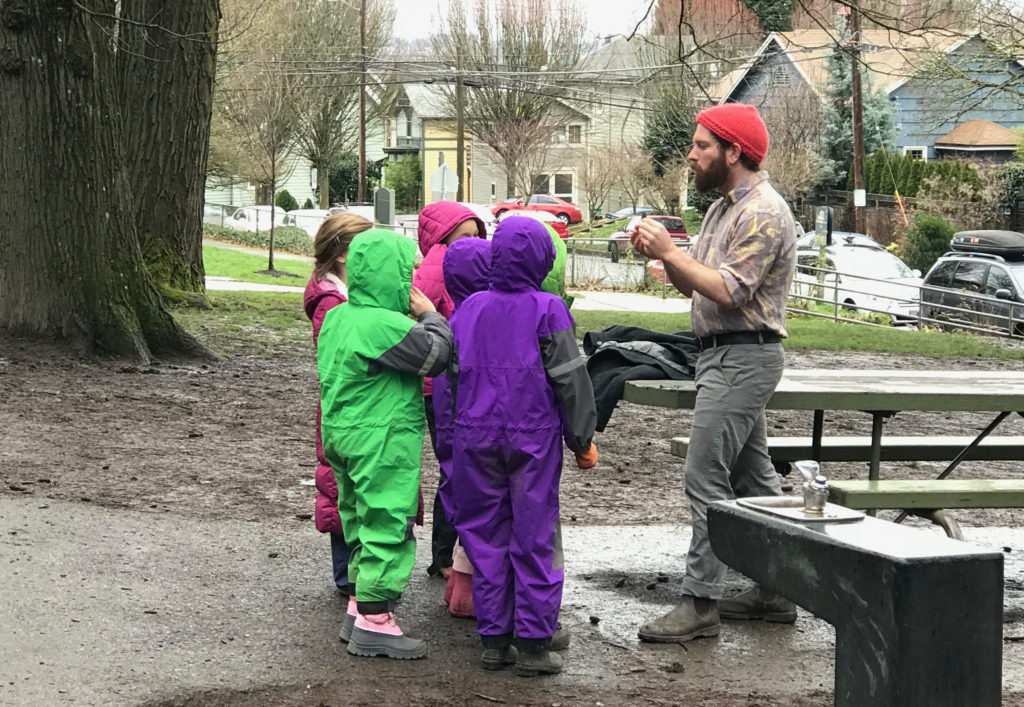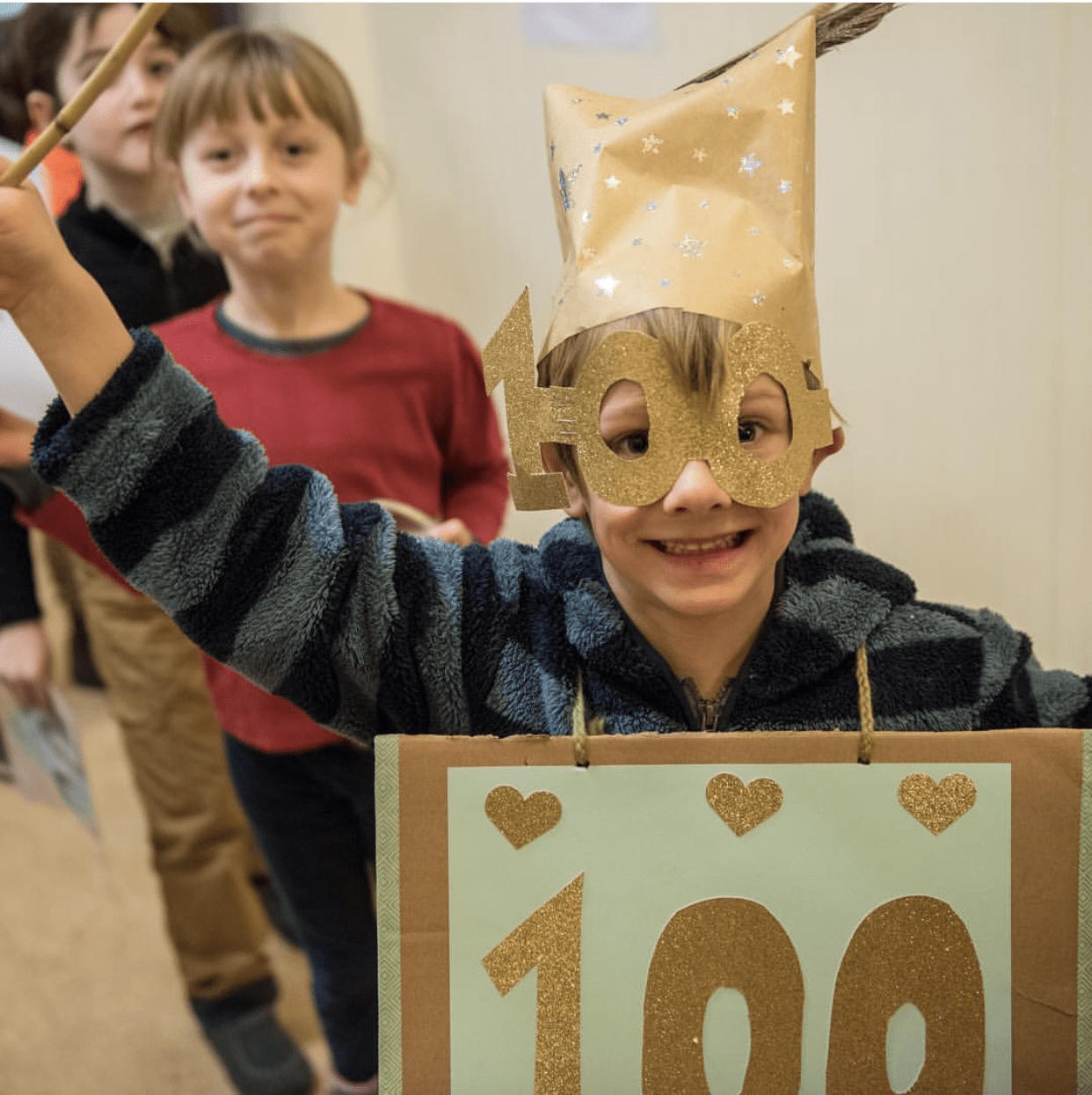It’s been far too long since I posted about what’s happening in first grade (other than my little Friday Reflections posts), I thought I’d take a few minutes to share about the four processes and other first grade happenings — stream of consciousness-style.

It’s a snowy Wednesday in Portland today, but we’re on February Break, so we’re off school anyway. My own children, who attend local Portland Public Schools were ecstatic to have the day home. February is a really good time for a break — my students and I were certainly feeling it in the couple of weeks before the break. We’ve had many children (and teachers!) out sick recently, so I’m glad to have a break from the petri dish that is the first grade classroom.
We just finished up a math block, in which I introduced all four processes. Traditionally, Waldorf teachers tell a story about the four processes represented by four different gnomes. It’s sometimes difficult for me to connect with gnomes, fairies and other elemental beings (can I still be a Waldorf teacher?), so instead I told a story about a queen who was helped by four different citizens of her kingdom. This made it easier for me to keep the genders balanced, too.
The Four Processes in First Grade
The characters who brought the four processes in our math stories were:
Queen Equality
She likes everything to be fair and so she has a grand, elaborate scale in her throne room. The top of the scale, when both sides are balanced, looks like an equals sign that goes straight across. (When one side is heavier than the other, the equals sign is tipped and Queen Equality is deeply dissatisfied.)
Porter Plus
He travels around the kingdom, from mine to mine, collecting gems for Queen Equality. I learned in my summer training in Sacramento that each of the processes can correspond to one of the temperaments. Porter Plus is phlegmatic, relating to the element of water. He is deliberate and methodical and accumulates bit by bit in a regular, repetitive way.
Mabel Minus
Many teacher depict the minus character as a gnome who has holes in his pockets. As he travels around the kingdom he carelessly and sadly loses gems. This, to me, did not really resonate so strongly with the aspects of the melancholic temperament that I want to draw attention to. At its most noble, the melancholic has an incredibly compassionate heart and deeply feels the suffering of others. So, instead of going around the kingdom losing gems, Mabel Minus found needy citizens and gave the gems away, so by the time she got to the queen she found that she had far fewer gems than she started out with. Of course, the queen was grateful for Mabel’s service to her citizens.

Tanya Times
Tanya Times has two pigtails on the side of her head. She barges into the counting room doing cartwheels just when Porter Plus is trying to add up how many gems he found on a recent trip. She represents the sanguine temperament and she shows him a quick and easy way to record the gems he finds.
Devin Divide
Once the gems are brought back to the castle, the queen asks for the assistance of Devin Divide. He takes all of those gems and quickly makes decisions about how many gems each of the citizens should receive. He represents the choleric temperament who makes no nonsense about deciding what is fair and even.
While I love all of the story content that you can find in Waldorf resources, I really appreciate traditional resources for helping me understand the best way to help my students work with and understand the concepts we’re working with. For math, nothing beats the resources put out by John Van der Walle. His books endorse a “developmental” approach to math that emphasizes working with number sense, rather than learning tricks and techniques for solving math problems.
Teaching Student-Centered Mathematics for K-2 is the book that guided my work for this block and I found lots of class activities that helped me determine where my students were with number sense. There are plenty of skills we take for granted that children know, but it’s good to confirm with a couple of little games. (The version I used has a slightly different cover than the one in this picture.)
It looks like they have a series of companion books called “field guides” that have details about activities, expanded lessons and assessment tasks. Might have to add those to my library next.
Math Stories
I’ve mentioned before that I’ve been somewhat dissatisfied with the little stories that I make up to bring math concepts. The fairy tales are just so rich, I can’t bear to leave them behind, even during a math block. But for this block, I did. Queen Equality and her subjects were our sole story content during the math block. So I really had to live with the stories to make the images come to life, so I wouldn’t feel like I was making up details on the spot (not that the first graders would notice, but I like for those images to be quite intentional.)
We’re heading into a language arts block when we get back, though, so I’m looking forward to getting back to the fairy tales.
Celebrations
The last week before the break was a week full of celebrations. In addition to a couple of birthdays, we had a Valentines Day celebration with our 8th grade buddies.

I’m a huge fan of pulling out the crafting supplies and letting the creative magic happen. It was especially fun with the 8th grade buddies.
The biggest celebration, though, by far, was our Day 100 parade.

This ended up turning into a far bigger event than I ever anticipated, thanks to the enthusiasm of the first graders. We’ve been counting the days since the beginning of the year, imagining what we might do for the 100th day. It happened that Day 100 was February 15, so we had two big days in a row.
Leading up to the big day we made signs and posted them around the school announcing the day. Some children made signs and costumes at home and the parents helped me surprised the first graders with 100 balloons in our classroom. On the day, the children all brought 100 of something from home (pinto beans, pennies, dragon tears — one child even brought 100 worms!)
The big event, though, was that we went around to every classroom in the school and counted to 100 with each class. This meant that we counted to 100 twelve times! It was so much fun and a perfect way to wrap up our math block!
Back to Language Arts!
When we return to school after the February Break (along with everyone hopefully being healthy again) we’ll begin working with sight words. I decided to do our work with word families earlier in the year, saving sight words for after the first graders had learned the lower case letters. I’m finding that many of the first graders are still most comfortable writing the upper case, but are fine with starting to explore identifying the lower case letters. Ultimately, I see the most value in the students learning the sight words in their lower case form, so I imagine we’ll be working with both upper and lower case as we learn the sight words. I’ve got a couple of great resources on working with word walls and guided reading and writing that I’ll be using to prepare for this block (which is the task of the next few days.)
First Grade Skills
Are you tracking your students' skills? Report-writing time will be here before you know it. Start tracking those skills with this handy form.
Class Play
The other big event on our horizon is our class play, which we’ll perform just before spring break (just 4 weeks after we return.) I’ve been thinking a lot about all of the stories I’ve told and there are a couple that stand out to me as good contenders for a class play. I look for stories that seemed to make an impression on me and the students. Of course, I haven’t found a written version of either of them, so I imagine I’ll be writing my own. I have written plays a couple of times over the years, and my preference is definitely to avoid writing my own from scratch. But, since the first grade play is traditionally spoken as a chorus, without individual parts, I’m thinking I can probably manage it.
As for parts, I do imagine we will have different children acting out different parts of the play, but I think they will all learn all of the parts. I kind of like the idea of holding the costumes in my hands and putting them on the children (thereby giving them their parts) once we are already onstage and about to begin. In this way it feels much more like the dramatic reenactments we do all the time in the classroom, without the stress and worry about playing a particular part.





Leave a Reply